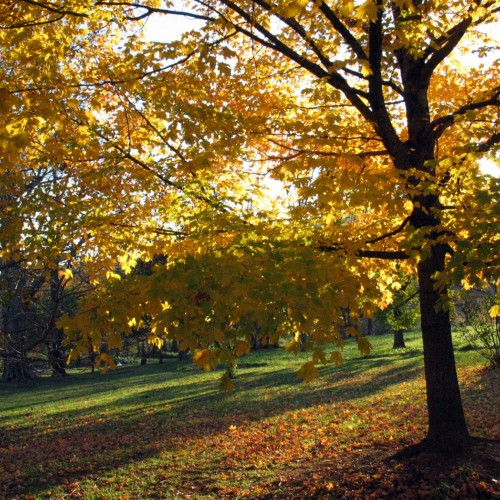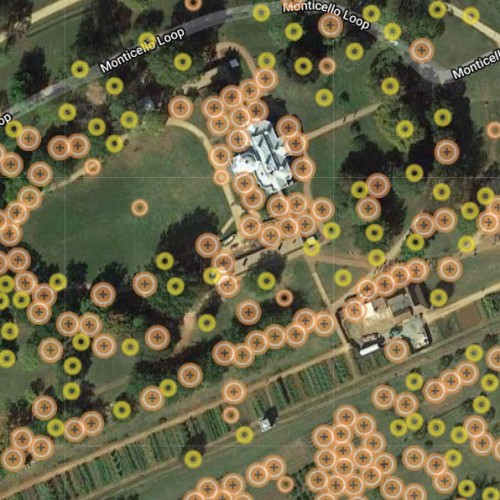I never before knew the full value of trees. My house is entirely embossomed in high plane-trees, with good grass below; and under them I breakfast, dine, write, read, and receive my company. What would I not give that the trees planted nearest round the house at Monticello were full grown.
--Jefferson to Martha Randolph (from Philadelphia), 1793
Jefferson undoubtedly ranked trees at the top of his hierarchical chart of favorite garden plants. Visitors to Monticello were often given tours of the grounds, which included a rambling survey of what one guest described as Jefferson's "pet trees." The image of lofty shade trees crowning the summit was constantly reiterated by visitors to Monticello. Even in his most functional plantings, Jefferson exploited the ornamental qualities of 160 species of trees. He planted groves of native and exotic trees; "clumps" of ornamentals adjacent to the house; "allées" of mulberry and honey locust along his road network of Roundabouts; plantations of sugar maple and pecan; and living peach tree fences to border his fields.
While serving as Minister to France between 1784 and 1789 Jefferson proudly distributed seeds of choice North American trees to friends in Europe, continuing a tradition begun with the earliest European explorers in the New World. He has been described as "the father of American forestry" for an 1804 planting of white pine and hemlock. His commitment to tree preservation was strongly suggested by a statement he allegedly made during a dinner conversation at the President's House: "I wish I was a despot that I might save the noble, beautiful trees that are daily falling sacrifice to the cupidity of their owners, or the necessity of the poor. . . .The unnecessary felling of a tree, perhaps the growth of centuries, seems to me a crime little short of murder." Thomas Jefferson's enthusiasm for the arboreal world was unrelenting. Two months before his death, at the age of eighty-three, he designed an arboretum for the University of Virginia. Such an epilogue to years of planting at Monticello was perhaps inspired by Jefferson's own adage: "Too old to plant trees for my own gratification I shall do it for posterity."
Native trees were often selected for functional purposes, while exotic trees fell into the "pet tree" category. Several specimens, original trees, survived the inhospitable environment of mountaintop experience into the 1990s. These included a still-standing (as of 2018) red cedar (Juniperus virginiana) -- a species which, surprisingly, Jefferson said was introduced into his Albemarle County; a sugar maple (Acer saccharum), the lone survivor of his efforts to create sugar plantations in central Virginia; and, a European larch (Larix decidua). Two impressive Jefferson-era, native tulip poplars (Liriodendron tulipifera) adjacent to the house lasted until the early 21st century. And until 2001, when it fell victim to disease, a purple or copper beech (Fagus sylvatica 'atropunicea'), grew in "an angle" at the southwest corner of the house as a replacement for a Jefferson-era tree blown down in the 1950s; another copper beech stands in the northwest angle of the terrace that extends from the northern side of the house.

